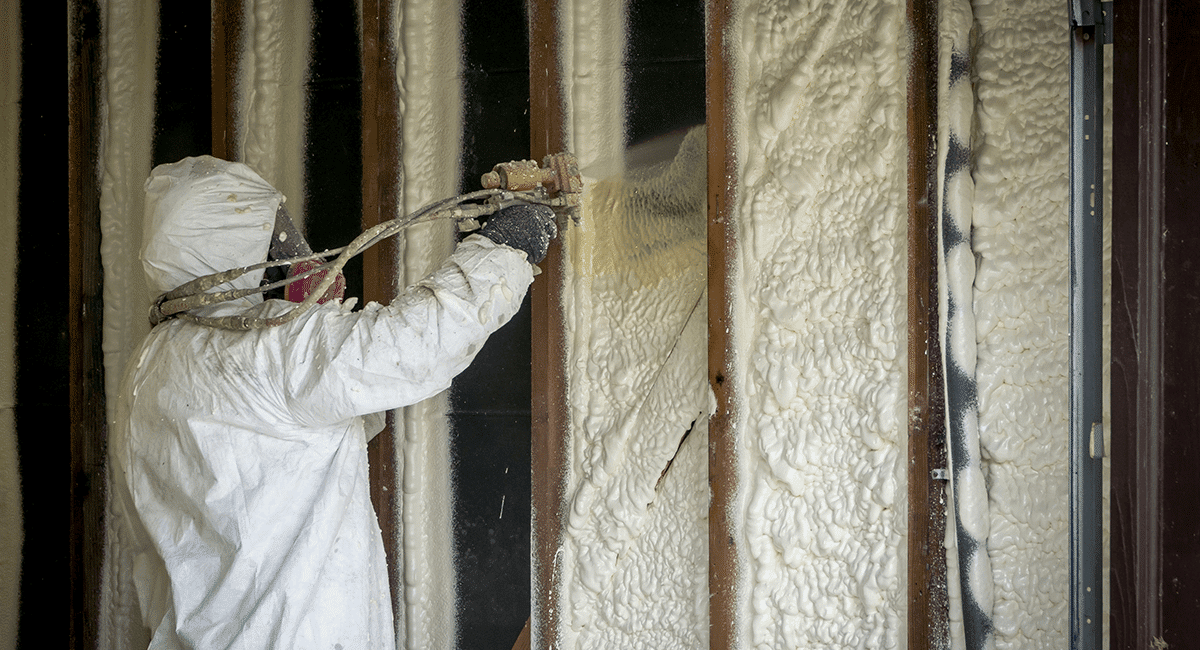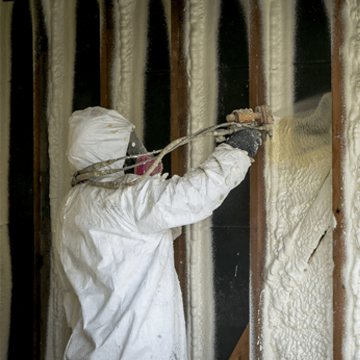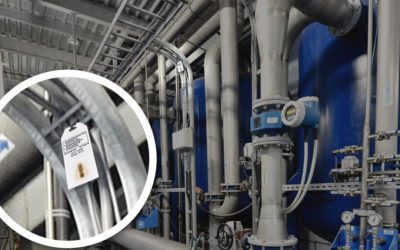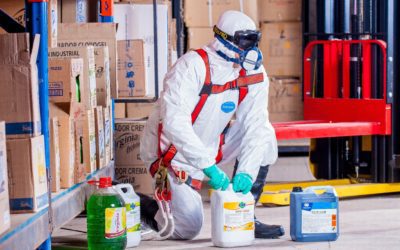POLYURETHANE
– Chemical Detection in the Polyurethane Industry
Forming chemical safety procedures for polyurethane production
Polyurethane (PU) is a versatile material capable of almost infinite structural variations for a multitude of applications. This useful material is present in many items found in everyday life, from foam in furniture to wheels on skateboards. Although polyurethane products are common, the process of creating them is out of the ordinary. Polyurethane formulations mix isocyanates with polyols to create a wide variety of polyurethane foams and other products. Workers who come in close proximity to these polyurethane chemicals in their raw form or during the PU production process risk occupational exposure to isocyanates like toluene diisocyanate (TDI) and methylene diphenyl diisoscyanate (MDI). TDI & MDI exposure can be hard to monitor, as polyurethane materials have the potential to release isocyanates until they are fully cured. SafeAir TDI/MDI badges help keep employees safe when working with the toxic chemicals used in the polyurethane industry.

– DESIGNED FOR THE POLYURETHANE INDUSTRY
CHEMICALS DETECTED

TDI/MDI

PHOSGENE
– POLYURETHANE –
NEWS & UPDATES
The Big Deal – Chemical Detection
What is Chemical detection and why do we need it? Believe it or not, the need for chemical detection is not just prevalent in chemical labs and big science corporations. In fact, the need spreads out over almost every industry in one way or another. From sanitizing...
If I have an area monitor, do I need to do personal monitoring?
Great question! First, let’s quickly talk about what is the difference between an area monitor and a personal monitor. An area monitor, like the name describes, is an instrument placed in a specific area to monitor the chemical concentration in that...
Exposure dose for dummies
To answer the question of how fast SafeAir badges will react, we will need to know the concentration of the chemical present in the environment as well as the overall time of the exposure. For example, the SafeAir TDI/MDI badge has an initial indication dose sensitivity of 5 ppb●hr, meaning at a concentration of 5 ppb of TDI, this badge will indicate exposure after being in the environment for one hour.
– HOW WE DO IT –
SOLUTIONS
Automotive
Polyurethane is used to make many key structural, functional, and aesthetic parts that go into cars. PU foam makes up the seat cushioning the ride, the adhesive securing the windshield in place, and the paint making up that shiny new finish. Thermoplastic polyurethane (TPU) parts are also present in many automobiles. Isocyanates are used in the manufacturing processes for urethane parts and in the coatings sprayed on cars and trucks to protect them from weather and rust. Workers in the automotive industry who come in close proximity to isocyanates have the potential to be exposed. SafeAir MDI and TDI badges help to keep workers safe from the risk of isocyanate exposure in an affordable, easy to use, and fast acting detection platform.
Coatings, Adhesives, Sealants, & Elastomers (CASE)
TDI & MDI along with some of their aliphatic isocyanate counterparts are used in the production of sealants, adhesives, coatings, and elastomers. Employees manufacturing these products run the risk of isocyanate exposure by being in close contact with such compounds. The SafeAir TDI & MDI badge indicates the presence of aromatic isocyanates helping to protect employees from the risk of occupational exposure.
Furniture & Mattresses
A large portion of the world’s annual polyurethane foam production goes into making the chairs, couches, and mattresses that keep us comfortable. Isocyanates are combined with polyols to form plush flexible foams which are then cut, molded, and stuffed into the cushions and cases that make up the finished furniture product. Workers who come in close proximity to uncured foam and foam being cut with heated methods, such as lasers or hotwire cutting, risk isocyanate exposure from the vapors that are released by the foam. SafeAir badges help to keep employees safe from isocyanate exposure when working in close proximity to hazardous isocyanate fumes.
Spray Foam
Spray foam is used throughout the building and construction industry to insulate structures. Spray foam is typically generated on-site using specialized equipment which mixes polyurethane formulations containing MDI and polyols. Spray polyurethane foam (SPF) technicians and applicators are aware of the hazards occupational exposure to isocyanates like MDI pose. While these professionals typically use supplied air breathing respirators when spraying foam, MDI exposure remains a challenge facing the spray foam industry. SafeAir badges make detecting MDI and monitoring employee exposure to isocyanates easy. With the proper training, respiratory protective equipment, and isocyanate detection equipment, occupational exposure to isocyanates can be minimized. SafeAir MDI badges help to protect spray foam applicators and their helpers from the hazard of isocyanate exposure.
Spray Coatings
Similar to spray foam applications, spray polyurethane coatings are applied directly to the surface being treated. These coatings are used to protect buildings, floors, vehicles, roofs, and equipment from exposure to the elements. Urethane coatings provide exceptional weathering performance characteristics and are the coating of choice for many contractors. Applicators spraying these coatings and those working in close proximity to them run the risk of isocyanate exposure. Until these coatings are fully cured, they have the potential to release harmful isocyanate vapors. SafeAir badges help to protect workers from isocyanate exposure when working with spray polyurethane coatings.
Slabstock Foam Production
Used in the production of both rigid and flexible foams, isocyanates are mixed on a conveyor belt with polyols to form different types of polyurethane foam. Different combinations in the polyurethane chemical mix, as well as other technical factors like temperature, dictate the properties the finished foam will have. Polyurethane formulation technicians and chemists work to find the best type of foam for a specific application. Open cell foams are used for soft flexible applications and closed cell foams are used in applications requiring rigid foam. Workers in close proximity to polyurethane slab stock production lines risk exposure to polyurethane chemicals such as isocyanates. SafeAir badges can be used to determine each employee’s exposure to isocyanates. Because they monitor each employee, SafeAir badges provide an added layer of safety when used in conjunction with stationary isocyanate detectors. SafeAir TDI & MDI badges help to ensure employees are safe from isocyanate exposure when working in polyurethane foam production facilities.
Isocyanate Production
Chemical plants produce millions of tons of isocyanates a year, using phosgene gas as a precursor in a reaction that forms isocyanates. Phosgene, a deadly pulmonary-agent which was used as a chemical weapon during WWI, is now used as a chemical building block in the production of isocyanates for polyurethanes as well as other products such as polycarbonate plastics. Due to its scheduling as a chemical weapon and the strict safety precautions needed, phosgene is not usually transported. Instead, it is typically produced in a closed system using carbon monoxide and chlorine gas, and then used up within the same plant in the production of isocyanates or other chemicals. Employees at isocyanate production plants risk phosgene exposure, as well as exposure to other chemicals such as isocyanates and chlorine. SafeAir phosgene badges have been widely adopted by the industry for their ability to monitor employee exposure to phosgene and to immediately and accurately alert the user to an exposure.
– EXPERIENCE YOU CAN TRUST
MORE INDUSTRIES SERVED
– GET IN TOUCH –







